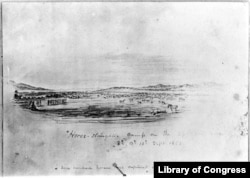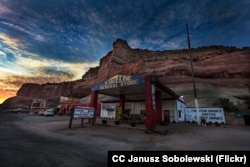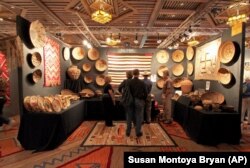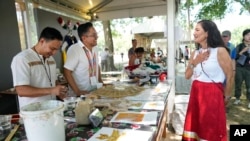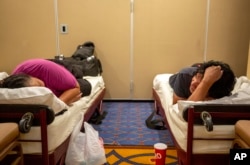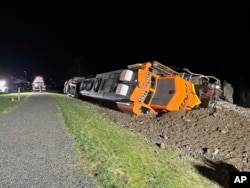Native Americans
Native American News Roundup, August 21-27, 2022

Here is a summary of Native American-related news around the U.S. this week:
Air Force Base in Washington State to Rename Housing Units
Fairchild Air Force Base in Washington State has announced it will change the names of all parts of the base named after George Wright, a 19th-century Army general with a record of unusual cruelty against tribes in the northeast of the state.
"We are renaming Ft Wright Village and Ft Wright Oval in base housing to Lilac Village and Willow Loop," Fairchild Air Force Base posted on Facebook Monday. "This change is the result of long consideration by Fairchild leadership, in accordance with an Air Force directive to evaluate historically divisive names on installations."
In the autumn of 1858, then-Colonel Wright launched a two-month campaign against the Spokane, Palouse and Coeur d'Alene tribes to avenge an Army defeat several months earlier.
Donald Cutler, in his book "Hang Them All": George Wright and the Plateau Indian War, 1858, described Wright's strategy for dealing with tribes, writing, "Col. Wright, by admitting his intent was to strike fear into the tribes, showed that he understood the power of cruelty."
Wright captured and slaughtered 900 Indian horses, burned tribes' crops and food supplies, and staged public hangings that Cutler describes as "theatrically gruesome."
Fairchild's announcement generated some criticism on Facebook, coming amid vigorous debate in the U.S. about history, democracy and patriotism in America, which has seen the removal of dozens of Confederate and Christopher Columbus statues and reviews of the way history is being taught in some school districts.
In 2021, the city of Spokane, Washington, renamed a street that formerly carried Wright's name. The new name is Whistalks Way, after a Spokane woman warrior who played a key role in resisting Wright.
Air Force erasing decorated Union Army veteran from base over 'brutal acts' towards Native Americans
Labor Department to Boost Native American Employment, Training Programs
The U.S. Department of Labor has announced the award of $70.8 million in grant funding to 166 Indian and Native American tribes and organizations to help provide employment and training services to low-income and unemployed Native Americans, Alaska Natives and Native Hawaiians to help them compete in today's workforce.
Of the funds awarded, $56,351,790 will serve low-income and unemployed American Indians, Alaska Natives and Native Hawaiians. The remaining $13,932,627 will serve low-income American Indian, Alaska Native or Native Hawaiian youth ages 14-24 living on or near Indian reservations or in Hawaii.
The unemployment rate for American Indians and Alaska Natives has declined since April 2020, the start of the COVID-19 pandemic, when it hit 28.6 percent, nearly double the seasonally adjusted rate of 14.7 percent for the total population.
The lack of employment and/or educational opportunities in or near Indian reservations is one of the biggest challenges to tribal well-being today. In February, for the first time ever, the Bureau of Labor Statistics published data showing that the Native American unemployment rate in December 2021 was 7.9 percent, a rate much higher than the rate of 3.9 percent for the general U.S. population.
Cherokee Lawmaker is GOP Nominee for US Senate Seat
Conservative U.S. Representative Markwayne Mullin of Oklahoma, a citizen of the Cherokee Nation, this week won the Republican nomination for the Senate seat currently held by James Inhofe, who is set to retire at the end of the year.
In November midterm elections, Mullin will face off against the Democratic candidate, former U.S. Representative Kendra Horn.
Mullin, a businessman and former mixed martial arts fighter, is widely viewed as the favorite in Oklahoma, where Republicans control the offices of governor, secretary of state, attorney general and both chambers of the state Legislature.
Markwayne Mullin wins Republican bid for U.S. Senator Inhofe's seat
Wailaki Astronaut to Head for the Stars
As a former Marine Corps test pilot, Nicole Aunapu Mann, a Wailaki citizen of the Round Valley Indian Tribes in Northern California, has flown on many missions, but none can compare to the flight she's about to undertake next month: commanding a crew of five on a SpaceX flight to the International Space Station.
Once she reaches the ISS, she'll spend six months conducting science experiments.
"One of the ones that I'm looking most forward to is called the biofabrication facility. And it is literally 3D printing human cells," she told Jourdan Bennett-Begaye, editor of Indian Country Today.
Scientists have long envisioned using 3D biological printers to print human organs, but they've found it nearly impossible to print finer tissue, such as capillaries, in Earth's gravitational environment. That's because gravity flattens and deforms 3D-printed tissue. But in space, the lack of gravity allows 3D printed tissues to hold up.
Flying with Mann will be NASA astronaut Josh Cassada, Japan Aerospace Exploration Agency astronaut Koichi Wakata and Russian cosmonaut Anna Kikina.
In 2002, John Herrington of the Chickasaw Nation in Oklahoma became the first Native American in space.
September's space trip may not be Mann's last: In 2020, she was also selected to be one of a group of eligible astronauts to travel to the moon as part of NASA's Artemis program.
Pueblo Potter Takes Top Prize in Santa Fe Indian Market
Over the weekend, the Southwestern Association for Indian Arts announced winners of the 100th annual Santa Fe Indian Market in New Mexico, the largest Native North American art market in the world.
San Ildefonso Pueblo potter Russell Sanchez won best in show — and a $30,000 award — for a lidded clay jar described as a contemporary interpretation of traditional Pueblo craftsmanship.
A bear stands atop the lid, an animal the Pueblo people associate with strength and protection. Winding around the center of the jar is the deity Avanyu, a plumed water serpent to whom Sanchez's ancestors appealed to in times of drought.
Sanchez still fires his clay pieces outdoors in the traditional Pueblo manner, using cedar and dried cow or horse dung as fuel. He then carves, paints and polishes his pieces, which are inlaid with minerals and gemstones.
Navajo silversmith Ernest Benally won best in the jewelry category for a belt made of a dozen turtles, each embedded with turquoise, lapis lazuli and other gemstones.
To see the full list of winners in 10 categories, click on the link below; to see photos of the winning artworks, visit SWAIA's Facebook page.
Santa Fe Indian Market Announces Centennial Best of Show Winners
Digital Solution Aims to Thwart Counterfeiters of Native Art
In a related story, counterfeit Native American art is a big problem in the U.S. and abroad. Jewelry, paintings and crafts falsely marketed as Native-made make big money for fraudsters but drive down the value of genuine Native art and denies Native artists a livelihood.
In one highly publicized case, federal investigators in 2015 raided 11 jewelry and Indian arts stores in New Mexico and California, seizing 350,000 pieces of Filipino-made jewelry with a retail value of $35,000,000.
This week, the art security registry Imprint announced it would partner with the Southwestern Association for Indian Arts to supply 800 Native American artists with permanently certified Imprint digital titles to their artwork.
Imprint gives artists and galleries permanent digital titles that allow them to officially register and create a digital certificate of authenticity that will be stored on a secure blockchain database — a digital "ledger" of all art transactions.
This means that buyers of Native artwork can be sure that they are getting works by legitimate Native artists, not frauds. Squeezing out the fakes means that genuine Native artworks retain or increase their value.
"When Imprint approached us to launch their blockchain-based art security registry with SWAIA artists, we immediately recognized the opportunity as one that will help combat theft and counterfeit within the Native American art world," said SWAIA Executive Director Kimberly Peone, an enrolled member of the Confederated Tribes of the Colville Reservation in Nespelem, Washington, and an Eastern Band of Cherokee descendant. "We are thrilled to be able to provide cutting-edge solutions to SWAIA artists."
The Indian Arts and Crafts Act of 1990 was intended to protect Native American artists by imposing fines and prison time for counterfeiting. Any individual falsely selling or presenting work as Native American can face civil or criminal penalties up to a $250,000 fine and/or a five-year prison term; any business selling fakes can face civil penalties or can be prosecuted and fined up to $1,000,000.
See all News Updates of the Day
Ship traffic in Bering Strait a threat to Native Alaskan subsistence hunting

EDITOR'S NOTE: A previous version of this article misidentified Andrew Mew. A correction has been made.
Each spring, as the Alaska ice pack begins to loosen, Pacific walruses migrate north through the Bering Strait toward the colder waters of the Arctic Ocean. On their way, they pass Little Diomede Island, home of the federally recognized Native Village of Diomede (Inalik), nestled in the middle of the strait.
This is the time of year Inalik hunters set out in small boats, hoping to hunt and harvest enough walrus and oogruk (seal) to see them through the months ahead.
On June 14, Diomede's environmental coordinator Opik Ahkinga received a distressing Facebook message from an "outsider" asking whether she was aware that a large American cruise ship, Holland America's Westerdam, would be stopping for a "scenic tour" of Diomede in just five days.
"The Inalik Native Corporation and Native Village of Diomede have never given permission to the Holland America line to use Diomede Alaska as a scenic stop," Ahkinga told VOA. "If we're going to have ships come unannounced, there are going to be hunters out there still hunting."
The Westerdam, more than 285 meters (936 feet) long and 32 meters (106 feet) wide, was carrying some 1,700 passengers on a 28-day Arctic Circle cruise timed to coincide with the summer solstice.
It is a ship that would scare off any walruses in the area. Furthermore, where Diomede's hunters once used arrows and harpoons to hunt for food, today they use rifles, posing a danger to passing vessels.
Directing traffic
A U.N.-designated international strait, Bering is a key passageway for domestic and foreign-flagged vessels sailing from the Pacific Ocean to the Arctic. Increased mining and petroleum activities to the north have led to a dramatic increase in ship traffic through the strait.
In summer 2016, the Crystal Serenity made history with a 32-day cruise from Anchorage through the Northwest Passage to New York, via Greenland.
"That was big news, and there's been an uptick in cruise ships and sightseeing ever since," said Steve White, executive director of the Marine Exchange of Alaska, a Juneau-based nonprofit that works to prevent maritime disasters.
In 2018, the International Maritime Organization (IMO), a U.N. Agency, adopted a set of routing measures for large vessels moving "in the region of the Alaska Aleutian Islands." Those included recommended routes, areas of concern and areas to be avoided.
But these measures are voluntary, and while numerous groups including the Coast Guard and Marine Exchange monitor vessel traffic, "overall, it's not heavily regulated," White said.
VOA reached out to the Anchorage-based Cruise Line Agencies of Alaska's vice president Andrew Mew, who responded by email about the potential conflicts between ships and Native Alaskans hunting, fishing and conducting other subsistence activities.
"We make a practice of alerting vessels to the presence of subsistence activities when we are advised of them by the Coast Guard or other agency or organization," wrote Mew.
"There are some existent agreements in place regarding subsistence and commercial vessel activity, but … I am not aware of any agreement between a local Arctic organization and the cruise industry relative to subsistence activity."
He added, "When approached by members of the subsistence community, we are happy to pass along courtesy notifications to the vessels."
Recognizing that there is no centralized mechanism for communicating with Indigenous communities, the Marine Exchange has launched the Arctic Watch Operations Center, which White says is still in its "infancy stages."
Once fully up and running, Arctic Watch will monitor marine traffic and weather conditions, identify areas to avoid because of marine presence and share that information with vessel operators, Arctic communities, Alaska Native tribal governments and state and federal agencies.
Effort pays off
Cell phone service on Little Diomede is spotty in the best of times. On June 14, it was down altogether.
But Ahkinga is among the few Diomeders who has access to satellite internet. With time running short, she began sending emails in an attempt to divert the Holland America cruise ship.
VOA has seen copies of that email chain, which shows that her appeals were successful. Within two days, the ship changed course.
"While we are not aware of any notifications required to sail in this area of the Bering Strait, when we received a request from the Inalik Native Corporation to avoid that part of the sea, we agreed to alter the route and informed our guests of the change," a spokesman for Holland America told VOA in an emailed statement.
"As a cruise line that sails across the globe, we are committed to honoring and respecting the marine environment and communities who welcome us in our travel."
Washington folklife festival honors Indigenous culture, communities

Washington's National Mall was buzzing with activity Wednesday, despite temperatures surpassing 36 degrees Celsius (96.8 Fahrenheit). Groups of children played lacrosse while the dynamic notes of music and the savory aromas of food wafted along the grassy blocks.
Visitors found themselves immersed in the first day of the Smithsonian Folklife Festival, running through July 1. This year, the festival celebrates Indigenous communities.
The festival, which calls itself "an exercise in cultural democracy," began in 1967. Its programming generally focuses on a nation, region, state, or theme, seeing hundreds of thousands of visitors per year. Since its founding, the festival has hosted more than 25,000 guest performers, cooks, artists, and speakers.
The 2024 festival has pivoted its focus, honoring Indigenous communities in alignment with the 20th anniversary of the National Museum of the American Indian, which is adjacent to the Mall. Around 60 countries are being represented throughout the festival.
"Change is very much part of the festival … It's not cookie-cutter. It allows us to be flexible and to lean into moments that really are important," Sabrina Motley, director of the Smithsonian Folklife Festival, told VOA.
This year's festival is also on the shorter side, spanning just six days instead of the typical 10.
"We wanted to use the time before the 4th of July. The building itself, the thing we're celebrating, has a different life on the 4th of July," said Motley.
"It is becoming increasingly more difficult to ask people to come to Washington for two weeks … I'd rather have the most wonderful artists and cooks and dancers and musicians that we can find here for six days than to try to squeeze the festival into a longer period, which would be harder on the people that we're really meant to honor," she added.
Celebration strengthens bonds, says official
The 2024 festival began with a welcome ceremony in the museum's Rasmuson Theater, followed by an outdoor presentation of colors with Native American Women Warriors. Simultaneously, events were already happening on the National Mall.
"Every day that we celebrate, every day that we dance and sing and pray, we strengthen the bonds that assimilation policies sought to break among Native people. Thank you for telling our stories and keeping them alive," said U.S. Secretary of the Interior Deb Haaland at the welcome ceremony. Haaland is the first Native American to serve as a Cabinet secretary.
Crowds attending the opening ceremonies spilled into the rest of the museum and the National Mall, where tents with music, food, and activities were scattered across the grass.
Each day of the festival has dozens of indoor and outdoor events from late morning to early evening. There are musical performances, cooking demonstrations, and speaker discussions. Several events occur at the same time, and most span less than an hour, allowing visitors to pop between tents and performances.
While scheduled events are occurring, the "Festival Kitchen," a tent pitched outside the museum, sells a variety of food, such as Peruvian chicken, chicken empanadas, and Mexican chocolate gelato.
Music, fritters, lacrosse lessons
Despite the ongoing heat, the first day had a range of events.
In the late morning, the Gaudry Boys, a group specializing in folk music, played upbeat tunes on an outdoor stage as audiences tapped their toes against the lawn and bobbed their heads to the music.
Later in the day, Bradley Dry, a Cherokee chef, prepared corn fritters at the Foodways tent, an enclosure designed for cooking demonstrations. As he mixed a batter fragrant and orangey from smoked paprika and dropped the fitters into crackling oil, he spoke about his history with cooking, family, and culture.
"This [recipe] was something that was brought over with my family during the Trail of Tears. We don't have anything written down, but it's all just passed down through stories," he said. The Trail of Tears was a path taken by the Cherokee people when they were forcefully relocated from their homelands and moved to Oklahoma.
Other events from the first day included lacrosse lessons taught by Haudenosaunee tribal grouping athletes, a skateboarding workshop with Imilla Skate, a women's Indigenous skateboarding group, and evening blues piano.
Artistry, such as Tsimshian woodcarving and adornment and body art from Indigenous Brazil, was showcased throughout the day, while a temporary garden for the festival housed native plants.
The remaining days have a similar lineup, with events happening across the National Mall and museum.
Illinois may soon return land US stole from Prairie Band Potawatomi chief 175 years ago

Some 175 years after the U.S. government stole land from the chief of the Prairie Band Potawatomi Nation while he was away visiting relatives, Illinois may soon return it to the tribe.
Nothing ever changed the 1829 treaty that Chief Shab-eh-nay signed with the U.S. government to preserve for him a reservation in northern Illinois: not subsequent accords nor the 1830 Indian Removal Act, which forced all indigenous people to move west of the Mississippi.
But around 1848, the U.S. sold the land to white settlers while Shab-eh-nay and other members of his tribe were visiting family in Kansas.
To right the wrong, Illinois would transfer a 1,500-acre (607-hectare) state park west of Chicago, which was named after Shab-eh-nay, to the Prairie Band Potawatomi Nation. The state would continue providing maintenance while the tribe says it wants to keep the park as it is.
“The average citizen shouldn’t know that title has been transferred to the nation so they can still enjoy everything that’s going on within the park and take advantage of all of that area out there,” said Joseph “Zeke” Rupnick, chairman of the Prairie Band Potawatomi Nation based in Mayetta, Kansas.
It's not entirely the same soil that the U.S. took from Chief Shab-eh-nay. The boundaries of his original 1,280-acre (518-hectare) reservation now encompass hundreds of acres of privately owned land, a golf course and county forest preserve. The legislation awaiting Illinois House approval would transfer the Shabbona Lake State Recreation Area.
No one disputes Shab-eh-nay's reservation was illegally sold and still belongs to the Potawatomi. An exactingly researched July 2000 memo from the Interior Department found the claim valid and shot down rebuttals from Illinois officials at the time, positing, “It appears that Illinois officials are struggling with the concept of having an Indian reservation in the state.”
But nothing has changed a quarter-century later.
Democratic state Rep. Will Guzzardi, who sponsored the legislation to transfer the state park, said it is a significant concession on the part of the Potawatomi. With various private and public concerns now owning more than half of the original reservation land, reclaiming it for the Potawatomi would set up a serpentine legal wrangle.
“Instead, the tribe has offered a compromise, which is to say, ‘We’ll take the entirety of the park and give up our claim to the private land and the county land and the rest of that land,’” Guzzardi said. “That’s a better deal for all parties involved.”
The proposed transfer of the park, which is 68 miles (109 kilometers) west of Chicago, won Senate approval in the final days of the spring legislative session. But a snag in the House prevented its passage. Proponents will seek endorsement of the measure when the Legislature returns in November for its fall meeting.
The Second Treaty of Prairie du Chien in 1829 guaranteed the original land to Chief Shab-eh-ney. The tribe signed 20 other treaties during the next 38 years, according to Rupnick.
“Yet Congress still kept those two sections of land for Chief Shab-eh-nay and his descendants forever,” said Rupnick, a fourth great-grandson of Shab-eh-nay. “At any one of those times the Congress could have removed the status of that land. They never did.”
Key to the proposal is a management agreement between the tribe and the Illinois Department of Natural Resources. Rupnick said the tribe needs the state's help to maintain the park.
Many residents who live next to the park oppose the plan, fearing construction of a casino or even a hotel would draw more tourists and lead to a larger, more congested community.
“Myself and my family have put a lot of money and given up a lot to be where we are in a small community and enjoy the park the way that it is,” resident Becky Oest told a House committee in May, asking that the proposal be amended to prohibit construction that would “affect our community. It’s a small town. We don’t want it to grow bigger.”
Rupnick said a casino doesn't make sense because state-sanctioned gambling boats already dot the state. He did not rule out a hotel, noting the park draws 500,000 visitors a year and the closest lodging is in DeKalb, 18 miles (29 kilometers) northeast of Shabbona. The park has 150 campsites.
In 2006, the tribe purchased 128 acres (52 hectares) in a corner of the original reservation and leases the land for farming. The U.S. government in April certified that as the first reservation in Illinois.
Guzzardi hopes the Potawatomi don't have to wait much longer to see that grow exponentially with the park transfer.
“It keeps this beautiful public asset available to everyone,” Guzzardi said. “It resolves disputed title for landholders in the area and most importantly, it fixes a promise that we broke."
Native American news roundup, June 16-22, 2024

Feds acknowledge dams had ‘devasting impact’ on Pacific Northwest tribes
The Biden-Harris administration has released a report detailing the negative impacts that federal Columbia River dams have had, past and present, on tribal communities in the Pacific Northwest.
The report, part of the Interior Department’s efforts to support tribally led salmon restoration in the Columbia River Basin, is the first comprehensive federal documentation of the harms these dams have inflicted on eight tribal nations in the Pacific Northwest.
The dams have blocked fish migration, flooded sacred lands and transformed ecosystems, resulting in profound losses for tribal communities who have historically relied on salmon and other fish for both sustenance and cultural practices.
“Since time immemorial, Tribes along the Columbia River and its tributaries have relied on Pacific salmon, steelhead and other native fish species for sustenance and their cultural and spiritual ways of life,” Secretary Deb Haaland said in a statement.
“Acknowledging the devastating impact of federal hydropower dams on Tribal communities is essential to our efforts to heal and ensure that salmon are restored to their ancestral waters.”
The report includes recommendations to help the federal government fulfill its trust responsibilities and ensure a healthy Columbia River Basin for future generations: first to recognize and address the unique hardships tribes have faced because of federal dam construction in conducting future environmental reviews; to pursue joint stewardship and management agreements with tribes; to continue work to restore and unite fractured homelands, and to incorporate Indigenous knowledge in environmental decision-making.
Read more:
Truth and Healing bill advances in House
The Truth and Healing Commission on Indian Boarding School Policies Act of 2024 has passed markup in the House Education and Workforce Committee, a key step along the path to full passage.
HR 7227, a companion bill to S. 1723 which is sponsored by U.S. Reps. Sharice Davids, Ho-Chunk and a Democrat from Kansas, and Tom Cole, Chickasaw and a Republican from Oklahoma, would create a six-year commission to investigate the federal Indian boarding school system beyond what the Interior Department’s Federal Indian Boarding School Initiative.
The commission would be tasked with gathering records from local, state and religious institutions and taking testimony from survivors, tribes and descendants. It would also locate and identify Native children’s graves and document the ongoing impact of the boarding school system on tribes and survivors.
"I would not be here if not for the resilience of my ancestors and those who came before me, including my grandparents, who are survivors of federal Indian Boarding Schools,” said Davids, who co-chairs the Congressional Native American Caucus, said in a statement. “I am glad my colleagues came together today to advance the establishment of a Truth and Healing Commission, bringing survivors, federal partners, and Tribal leaders to the table to fully investigate what happened to our relatives and work towards a brighter path for the next seven generations.”
In a separate statement Cole said he is committed to investigating the abuses of the boarding school era.
“This Commission will hopefully bring these communities one step closer to healing and peace for themselves, their families, and future generations,” he said.
Read more:
Tribe opens its doors to community displaced by wildfires
The Mescalero Apache Tribe in south-central New Mexico this week declared a state of emergency after two wildfires broke out Monday on the northeast corner of their reservation.
Flames quickly spread to the village of Ruidoso and the city of Ruidoso Downs, prompting thousands of mandatory evacuations.
The tribe designated two sites for both tribal and non-tribal evacuees in the area and received a strong response to appeals for donations.
“We are extremely grateful for the willingness of our tribal members, neighboring towns and villages, community groups/organizations and complete strangers for the donations being dropped off at these sites,” the tribe noted on its Facebook page.
So far, the fire has claimed two known lives, burned 9,300 hectares of combined tribal and non-tribal land, and destroyed 1,400 buildings, 500 of them residential.
Railway fined whopping $400 million for trespassing on Native land
A U.S. District Court judge on Monday ordered the Burlington Northern and Santa Fe Railway, or BNSF, to pay the Swinomish Indian Tribal Community in Washington State just under $400 million for intentionally trespassing on their reservation.
A 1991 easement agreement allowed BNSF to run 25 train cars each direction per day and required BNSF to disclose the “nature and identity of all cargo.”
The tribe says in 2012, “unit trains” of 100 railcars or more were crossing the reservation, and by 2015, BNSF was running six 100-car “unit trains” per week across the reservation to a nearby refinery.
This resulted in significant profits, with revenues from the trespassing cars totaling about $900 million. During a recent four-day bench trial, both parties provided expert testimony on how to calculate the proportion of these profits that should be paid to the tribe.
“We know that this is a large amount of money. But that just reflects the enormous wrongful profits that BNSF gained by using the Tribe’s land day after day, week after week, year after year over our objections,” said Swinomish tribal chairman Steve Edwards. “When there are these kinds of profits to be gained, the only way to deter future wrongdoing is to do exactly what the court did today – make the trespasser give up the money it gained by trespassing.”
Read more:
US acknowledges Northwest dams have devastated the region's Native tribes

The U.S. government on Tuesday acknowledged, for the first time, the harmful role it has played over the past century in building and operating dams in the Pacific Northwest — dams that devastated Native American tribes by inundating their villages and decimating salmon runs while bringing electricity, irrigation and jobs to nearby communities.
In a new report, the Biden administration said those cultural, spiritual and economic detriments continue to pain the tribes, which consider salmon part of their cultural and spiritual identity, as well as a crucial food source.
The government downplayed or accepted the well-known risk to the fish in its drive for industrial development, converting the wealth of the tribes into the wealth of non-Native people, according to the report.
"The government afforded little, if any, consideration to the devastation the dams would bring to Tribal communities, including to their cultures, sacred sites, economies, and homes,” the report said.
It added: “Despite decades of efforts and an enormous amount of funding attempting to mitigate these impacts, salmon stocks remain threatened or endangered and continued operation of the dams perpetuates the myriad adverse effects.”
The Interior Department's report comes amid a $1 billion effort announced earlier this year to restore the region’s salmon runs before more become extinct — and to better partner with the tribes on the actions necessary to make that happen.
That includes increasing the production and storage of renewable energy to replace hydropower generation that would be lost if four dams on the lower Snake River are ever breached. Tribes, conservationists and even federal scientists say that would be the best hope for recovering the salmon, providing the fish with access to hundreds of miles of pristine habitat and spawning grounds in Idaho.
“President Biden recognizes that to confront injustice, we must be honest about history – even when doing so is difficult,” said a statement from White House Council on Environmental Quality Chair Brenda Mallory and Interior Secretary Deb Haaland, the first Native American cabinet secretary. “In the Pacific Northwest, an open and candid conversation about the history and legacy of the federal government’s management of the Columbia River is long overdue.”
Northwest Republicans in Congress and some business and utility groups oppose breaching the dams, saying it would jeopardize an important shipping route for farmers and throw off clean-energy goals. GOP Rep. Cathy McMorris Rodgers, who represents eastern Washington, called Tuesday's report a “sham."
“This bad faith report is just the latest in a long list of examples that prove the Biden administration’s goal has always been dam breaching," she said in a written statement.
The document was a requirement of an agreement last year to halt decades of legal fights over the operation of the dams. It lays out how government and private interests in the early 20th century began walling off the tributaries of the Columbia River, the largest in the Northwest, to provide water for irrigation or flood control, compounding the damage that was already being caused to water quality and salmon runs by mining, logging and rapacious non-tribal salmon cannery operations.
The report was accompanied by the announcement of a new task force to coordinate salmon recovery efforts across federal agencies.
Tribal representatives said they were gratified with the administration’s formal, if long-belated, acknowledgment of how the U.S. government ignored their treaty-based fishing rights and their concerns about how the dams would affect their people.
“The salmon themselves have been suffering the consequences since the dams first were put in,” said Shannon Wheeler, chairman of the Nez Perce Tribe. “The lack of salmon eventually starts affecting us, but they're the ones who have been suffering the longest. ... It feels like there's an opportunity to end the suffering.”
Salmon are born in rivers and migrate far downstream to the ocean, where they spend their adult lives before returning to their natal rivers to spawn and die. Dams can disrupt that by cutting off access to upstream habitat and by slowing and warming water to the point that fish die.
The Columbia River Basin, an area roughly the size of Texas, was once the world’s greatest salmon-producing river system, with as many as 16 million salmon and steelhead returning every year to spawn.
Now, scientists say, about 2 million salmon and steelhead return to the Columbia and its tributaries each year, about two-thirds of them hatchery raised. The Shoshone-Bannock Tribe in southeastern Idaho said it once harvested enough salmon for each tribal member to have 700 pounds of fish in a year. Today, the average harvest yields barely 1 pound per tribal member.
Of the 16 stocks of salmon and steelhead that once populated the river system, four are extinct and seven are listed under the Endangered Species Act.
Another iconic but endangered Northwest species, a population of killer whales, also depend on the salmon.
There has been growing recognition across the U.S. that the harms some dams cause to fish outweigh their usefulness. Dams on the Elwha River in Washington state and the Klamath River along the Oregon-California border have been or are being removed.
The construction of the first dams on the main Columbia River, including the Grand Coulee and Bonneville dams in the 1930s, provided jobs to a country grappling with the Great Depression, as well as hydropower and navigation.
As early as the late 1930s, tribes were warning that the salmon runs could disappear, with the fish no longer able to access spawning grounds upstream. The tribes — the Yakama Nation, Spokane Tribe, confederated tribes of the Colville and Umatilla reservations, Nez Perce, and others — continued to fight the construction and operation of the dams for generations.
Tom Iverson, regional coordinator for Yakama Nation Fisheries, said that while the report was gratifying, it remains “hopes and promises” until funding for salmon restoration and renewable power projects comes through Congress.
“With these agreements, there is hope," Iverson said. "We feel like this is a moment in time. If it doesn’t happen now, it will be too late.”




